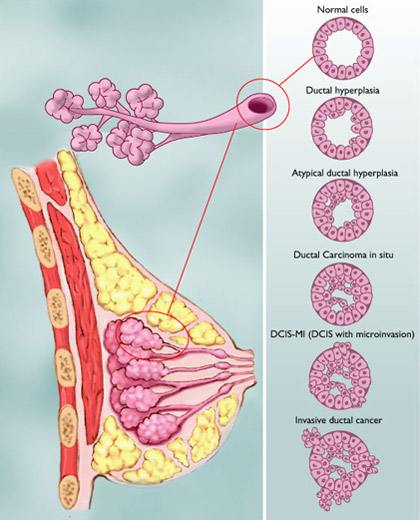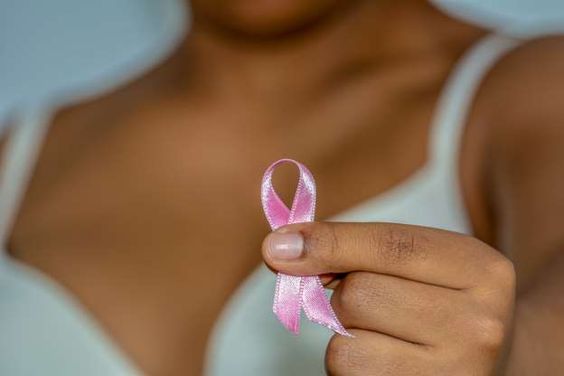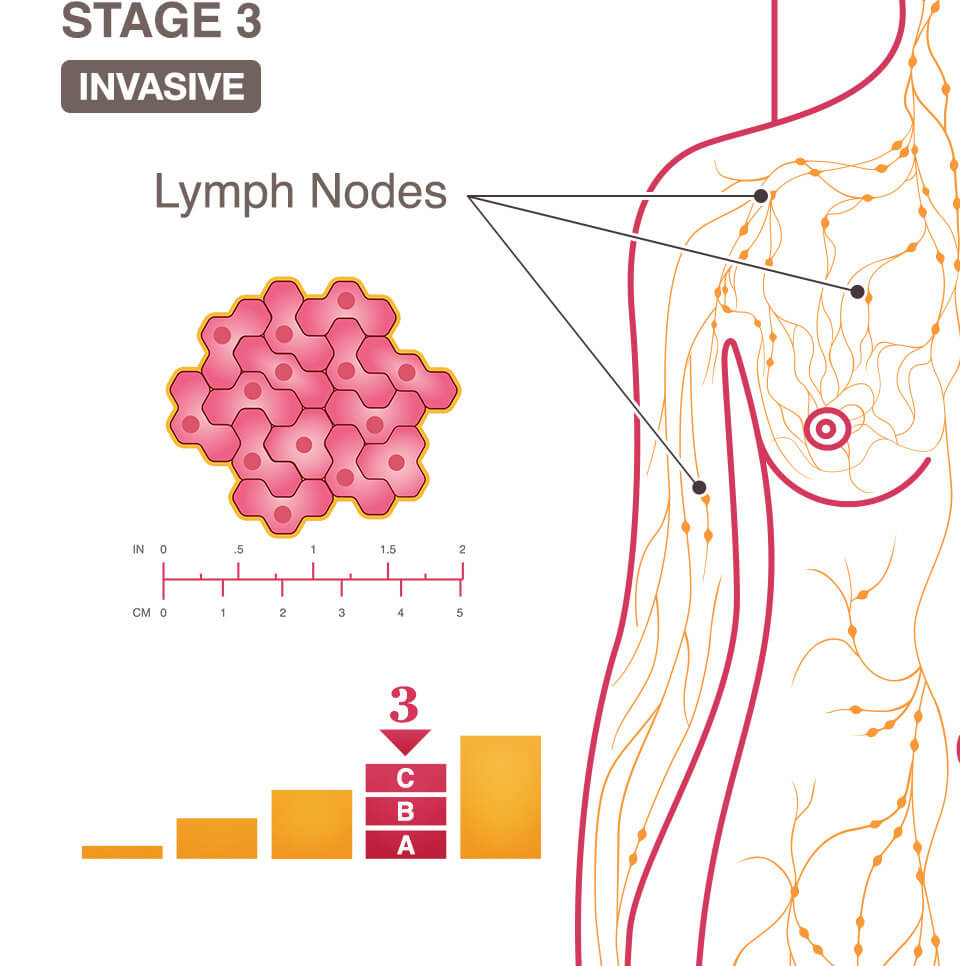Treatment of grade 3 breast cancer
Grade 3 breast cancer is a type of breast cancer that has spread to most nearby lymph nodes. Doctors also call breast cancer grade 3 when a tumor larger than 5 cm develops and the cancer has spread to all lymph nodes but not to more distant parts of the body.
In grade three, the cancer may have spread to the chest or even the skin of the breast.
It can be very frustrating for you to be diagnosed with grade 3 breast cancer, but life expectancy and treatments are increasing day by day.
Life expectancy and survival rate
According to the National Cancer Center in the United States, the survival rate for women with grade 3 breast cancer over a 5-year period is a maximum of 72 percent.
This means that 72 out of 100 infected women have a chance of surviving for 5 years after diagnosis.
For men with grade 3 breast cancer, the 5-year chance of survival increases dramatically to 75 percent.
By comparison, women with grade 0 and 1 breast cancer have a 100 percent chance of survival.
For grade 2 breast cancer, the chance is 93 percent, and for grade 4, the rate is 22 percent.
In men, these rates are 100% for stages 0 and 1, 87% for grade 2 and 25% for grade 4.
However, a person’s survival rate depends on various factors. Age, fitness, response to treatment, gender, tumor size and many other factors can affect a person’s survival rate.
Cancer treatment and prospects are constantly evolving, according to the American Cancer Society.
Also, a study that examines the 5-year survival rate of individuals shows the state of medical knowledge 5 years ago. This means that the survival rate of cancer patients may be higher than the statistics show.
Talk to your doctor for more accurate information on survival rates.

Treatment of grade 3 breast cancer
Treatment for grade 3 breast cancer, depending on the individual’s specific condition, usually includes medication and surgery.
Drug-based therapies can include chemotherapy, radiation therapy, cancer-specific drugs, hormone therapy, or a combination of these.
Chemotherapy involves the administration of drugs that kill the cancer cells. Chemotherapy has many side effects, but they usually go away after treatment.
Side effects of chemotherapy include:
Increased risk of infection
Anemia
Bruising and bleeding
nausea
Hair loss
Oral problems
Changes in the skin and nails
Memory and concentration problems
Menopausal symptoms
Fatigue
A course of treatment may begin with medication. The goal is to shrink the size of the tumor so that surgeons can remove it safely.
If a large tumor is not shrinking in size, your doctor may suggest removing the entire breast. This procedure is called a mastectomy.
Improve grade 3 breast cancer
Recovery occurs when the tumor is completely or almost completely removed. Recovery can be partial or complete.
Relative recovery means that some of the cancer is gone after treatment. Complete recovery means that doctors do not see any signs of cancer.
Recovery does not necessarily mean that there is no cancer left in the body. It just means that the doctor can not see it.
Cancer may never come back. However, it is not possible to make sure that the cancer is gone. So it may come back in the future.
If this happens, doctors call it chronic cancer. A person may need to experience periods of cancer recovery and recurrence for many years.
In some people, the cancer rate neither increases nor decreases. Doctors call this type of cancer controlled or stable.

Overcoming Breast Cancer
Despite significant advances in diagnosis and treatment, many people experience fear or trauma after being diagnosed with cancer.
When a person is diagnosed with breast cancer, he or she may experience a great deal of emotion, and each person’s reaction is unique.
In these situations, talking to loved ones or other people can be helpful. A person may also want to avoid hard work and spend time for themselves.
During the treatment of breast cancer, physical and mental changes may occur. For example, the side effects of chemotherapy can significantly reduce a person’s quality of life.
After a mastectomy, a person may find their physical changes psychologically challenging.
Removal of one or both breasts may affect a person’s personality, sexual orientation, or sexual orientation. This is especially true for young women.

Life expectancy and survival rate for grade 3 breast cancer are increasing over time. At present, the 5-year survival rate for grade 3 breast cancer is 72% in women and 75% in men.
However, many factors affect a person’s chances of survival after being diagnosed with cancer. The doctor can provide more detailed and personal information.
Excellent read, I just passed this onto a friend who was doing some research on that. And he just bought me lunch as I found it for him smile Thus let me rephrase that: Thanks for lunch!
great points altogether, you just gained a new reader. What might you suggest in regards to your publish that you made some days in the past? Any positive?
Hello There. I discovered your blog using msn. That is an extremely neatly written article. I will be sure to bookmark it and return to read extra of your helpful information. Thank you for the post. I抣l certainly comeback.
Hi! I just wanted to ask if you ever have any issues with hackers? My last blog (wordpress) was hacked and I ended up losing a few months of hard work due to no back up. Do you have any methods to stop hackers?
Excellent read, I just passed this onto a friend who was doing a little research on that. And he just bought me lunch because I found it for him smile Therefore let me rephrase that: Thanks for lunch!
This is really attention-grabbing, You are an overly professional blogger. I’ve joined your feed and look forward to looking for more of your great post. Additionally, I’ve shared your web site in my social networks!
Hey just wanted to give you a brief heads up and let you know a few of the images aren’t loading properly. I’m not sure why but I think its a linking issue. I’ve tried it in two different browsers and both show the same outcome.
I was recommended this blog by my cousin. I’m now not certain whether or not this post is written by way of him as no one else know such special approximately my problem. You’re amazing! Thank you!
It抯 really a cool and helpful piece of info. I am glad that you simply shared this useful info with us. Please keep us informed like this. Thanks for sharing.
Normally I don’t learn article on blogs, however I would like to say that this write-up very compelled me to take a look at and do so! Your writing taste has been surprised me. Thank you, quite great article.
Your writing style is truly engaging. illplaywithyou
I really like what you guys are usually up too.
This kind of clever work and exposure! Keep up the wonderful
works guys I’ve incorporated you guys to my blogroll.
I am really loving the theme/design of your site. Do you ever run into any internet browser compatibility problems? A small number of my blog visitors have complained about my blog not working correctly in Explorer but looks great in Safari. Do you have any solutions to help fix this problem?
If you are going for best contents like I do, just pay a quick visit this website daily since it offers quality contents,
thanks
excellent post, very informative. I wonder why the other experts of this sector do not notice this. You should continue your writing. I’m sure, you’ve a great readers’ base already!
This is very fascinating, You are an overly professional blogger. I’ve joined your feed and stay up for in quest of extra of your great post. Additionally, I have shared your web site in my social networks!
Have you ever considered about adding a little bit more than just your articles? I mean, what you say is important and all. Nevertheless think about if you added some great pictures or videos to give your posts more, “pop”! Your content is excellent but with images and video clips, this website could undeniably be one of the very best in its niche. Great blog!
Very interesting info!Perfect just what I was looking for!Leadership